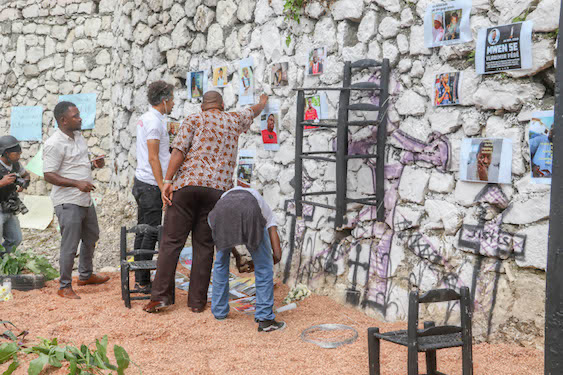By Gotson Pierre
P-au-P., July 23, 2024 [AlterPresse] — On the evening of July 23, 2024, the cries for justice of the peasants of Jean Rabel (North-West), massacred 37 years ago (1987), continue to resonate.
May the truth be definitively established, may the perpetrators be held accountable for their crime and punished, they proclaim in a press release sent to AlterPresse. As they do tirelessly every year. There is no room for oblivion.
Between July 23 and 27, 1987, approximately 139 peasants (official figure provided by the National Government Council/CNG at the time) were murdered by soldiers, former members of the Duvalier militia and large landowners.
A major peasant movement, “Tèt ansanm”, had taken root in Jean Rabel and was continually challenging the status quo. A social consciousness was developing within the peasant population.
More and more voices were being raised in favour of a State commitment to equitable and sustainable development, access to land, the establishment of agricultural infrastructure, access to credit, etc.
139 lives extinguished in indifference. 37 years of silence from justice.
La Saline, a sign of hope?
A sign of hope perhaps, the order of the investigating judge Jean Wilner Morin concerning the massacre of La Saline, an area in the north of the capital.
On the night of November 12-13, 2018, individuals armed with automatic weapons, fists and bladed weapons attacked residents of several neighborhoods in La Saline, causing dozens of deaths, the burning of several houses and the rape of many women and young girls.
- Memorial in memory of the victims of insecurity, erected in Bourdon, Port-au-Prince, in November 2020, on the occasion of the second anniversary of the La Saline massacre. Initiative of the organization “Nou pap dòmi”
No fewer than 85 victims were mentioned in the order made public last week. Nearly 6 years after the carnage, the judicial truth is therefore known.
The story is as follows:
“Individuals, members of an armed gang were mostly commissioned by politicians in power at the time with the aim of eliminating another gang, firstly, and taking control of the large public market of Croix des Bossales at La Saline, but had among other missions to prevent anti-government demonstrations organised by rival gangs in favour of the political opposition from making money.”
“The La Saline massacre was born out of a political conflict between gangs close to the government of the time and gangs declaring themselves to be in political opposition.”
“The central management of the judicial police in its report, reported nearly 75 complaints from victims of this carnage known as the La Saline massacre. The parents of the various victims who filed complaints with the Central Management of the judicial police and those heard at the investigating office accuse the Haitian National Police of laxity; for some, the police were forced not to provide assistance to the inhabitants of La Saline, targets of the armed bandits.”
“The massacre of La Saline, according to the statements of the victims, their close relatives and the police report, finds its explanation in the expansion of gangs encouraged and used by politicians of all ranks and all kinds according to their political interest. These politicians are mostly opposition activists or government officials sometimes operating through corrupt police officers in office or ex-police officers…”
These are the motives for the La Saline massacre, according to the conclusions of the judicial investigation. Apart from 3 deceased defendants, Grégory Antoine alias Ti Greg, Alectis Serge alias Ti Junior and Andris Iscar, 30 have been charged.
They are: “Hervé Barthélémy Bonheur or Léonel Altona alias Bout Jeanjean, Pouchon Jean, Nelson Mikelson, Josué François, Bergelin Etienne, Emanus Charles, Jameson Pierre, Policar Felanto, Kalison Rosiclair, Engy Exavier, Pyram alias Félix Toumber one , Chery Christ-Roi aka Chrislat, Cherizier Jimmy aka Barbecue , Joseph Pierre Richard Duplan, Fednel Monchéry, Manel Lundy, Sensiny Saint- Clair, Sadrac Brice, Manesse Gay, Eddyson Sony Laforest, , Pierre Richard St-Fort, , Polesse Dossous, , Pierre Michel alias Blanc piman machann bal, Wilson Alfred alias Grenn,, Max Dolph Desir, Bolliard Junior Alexis, Gerda Petidor, Cado Charles, Dahana Jean Michel et Pierre Léon Saint Remy ».
Before the criminal court without the assistance of a jury, they must answer for: “illegal possession of a firearm, murder, attempted murder, armed robbery, arson, kidnapping and sequestration and criminal association”.
We must focus on three specific cases: Jimmy Chérisier, alias Barbecue, a former police officer who became a gang leader, Fednel Monchéry, former director general of the Ministry of the Interior, and Pierre-Richard Duplan, former departmental delegate of the executive for the West.
“According to the statements of Ti Joel, as he was known, and the survivors of the massacre, the former police officers Jimmy Cherizier, alias Barbecue, and Grégory Antoine, alias Ti Greg, were both alongside the other bandits of La Saline, murdering men, women and children on the fateful night of November 12-13, 2018.”
“Rita Dieujuste, heard as a complainant at the investigating office on July 25, two thousand and twenty-three, regarding the events at La Saline, clearly stated that she had seen Jimmy Cherizier accompanied by bandits in sapates dressed in police uniforms sowing death among the peaceful citizens of La Saline.”
Regarding Fednel Monchéry: “Ms. Rita Dieujuste, heard as a victim at the investigating office in the presence of her lawyers, stated that she had seen Fedenel MONCHERY on several occasions in the La Saline area in his car, following him in a pick-up bearing the logo of the Ministry of the Interior and Local Authorities.”
“In her statements, Mrs. Rita Dieujuste insists on having seen the former Director General of the Ministry of the Interior, Fednel Monchéry, in the company of Joseph Pierre Richard Duplan in the La Saline area distributing weapons to gang members with a view to carrying out the La s’Saline massacre.”
“Mr. Ernst Leger, also a victim for having lost his child, claims to have seen Fednel Monchery at La Saline before the massacre and that the latter was with gang leaders planning these criminal acts which cost the lives of dozens of local residents at La Saline.”
“A summons to appear was served on the accused in order to present his version of the facts, however he preferred to send a handwritten letter to the Judge asking him to stay the investigation of the case.”
As for Joseph Pierre-Richard Duplan: he “was heard in the investigating chamber as the accused and denied everything that was brought against him, stating on the contrary that he had heard and read the information about the La Saline massacre in the media.”
“Confronted by the investigating office, two victims of the massacre (who) had declared having seen with their own eyes the former departmental delegate distributing weapons to the gang leaders of La Saline. (…) At the time of the confrontation, the victims repeated without being asked and with great reinforcement of explanations in the presence of the accused the same versions which Joseph Pierre Richard Duplan denied during the confrontation without however giving details and the correct information relative to where he was at the date and time reported by the victims.”
“The accused states that he does not remember what he was doing or at least where he was when the victims claimed to have seen him in the company of the saltworks gang leaders distributing weapons and very large sums of money for the perpetration of the massacre.”
Back to Jean Rabel: similar operating methods
When we go back 37 years, to Jean Rabel, it is possible to observe that the motives and methods of operation are similar, based on an interweaving of economic and political causes and mobilizing state resources.

- Peasant march in Jean Rabel on the occasion of the 36th anniversary of the massacre of July 23, 1987
The organization Tèt Kole Ti Peyizan recounts, in its press release on the occasion of the 37th anniversary of the massacre, that “the Tetansanm Group, the Janrabel Missionary Team and their allies, the Bitasyon Caritas Group and the Bochan Missionary Team in Port-de-Paix, as well as the Peasant Group and the Bombardopolis Missionary Team, carried out a socio-political, cultural and solidarity economy project in the North-West department, in the 1970s and 1980s. An alternative project that was very frightening.”
For their part, “the sworn enemies of the Haitian people were plotting savage responses and blows, as part of the implementation of policies of domination and violent aggression.”
“Small farmers demanded a state capable of acting on the means of production in order to allow them, as well as farmers, to have access to good land, state land, to irrigation canals (…) so that farmers could produce more, strengthen and protect national agricultural production and preserve the country from the invasion of foreign products and food aid.”
The small farmers of Jean Rabel, Mahotière and Bochan demanded “a State capable of providing the population with hospitals, dispensaries, laboratories, medicines and adequate and qualified personnel as well as the necessary medical infrastructure; primary, secondary and vocational schools and free public universities for young people.”
These are the demands that the peasant associations were making when they “rose up in the North-West against market taxes, disastrous food and the system of section chiefs”, specifies Tèt Kole.
The organization reports, among other things, that a month before the massacre, on June 14, 1987, “General Henri Namphy, president of the National Government Council (NGC), accompanied by Alphonse Jean, a big makout (supporter of the Duvalier dictatorship) before the Eternal, then a presidential candidate, went to boost the morale of the armed forces at Jean-Rabel.”
After the bloody Thursday, July 23, 1987 in Jean Rabel, a great potentate, also a landowner in the area, Nicol Poitevien, had claimed responsibility by boasting of “having assassinated 1,042 communists”. Nicol Poitevien, who was arrested, under the presidency of René Préval, in connection with this massacre, was later released. Other alleged perpetrators and accomplices were also released.
The fact is that no real investigation has been conducted into the crimes committed on July 23, 1987 in Jean-Rabel. It is an investigation that is ongoing, as for most of the files kept in the drawers of justice over the last decades. There would be so much to do yet. Because, before and after February 7, 1986, the date of the fall of the ferocious Duvalier dictatorship, there were massacres, in periods of unrest, agitation and socio-political mobilization, across the country.
The judicial truth is therefore known about La Saline, without a judgment appearing on the horizon for convictions to be pronounced. A first all the same! But the road leading to the assault on the citadel of impunity will perhaps be very long. [gp apr 23/07/2024 22 :00]






